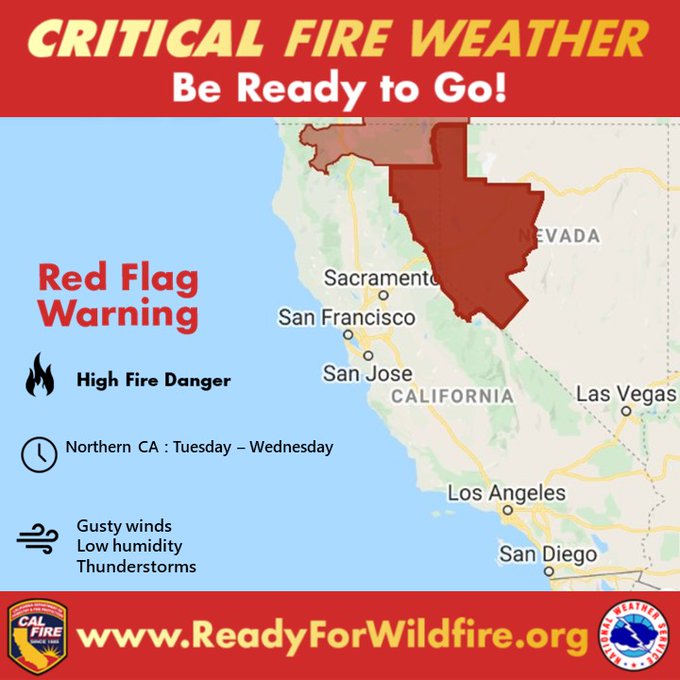
The National Weather Service yesterday issued a red flag warning (very high fire danger) for the Lake Tahoe Basin. A red flag warning is the highest alert issued by the weather service.
The warning, which lasts through 9 pm tonight, also covers areas of Lassen National Forest, Plumas National Forest, and Reno.
...RED FLAG WARNING NOW IN EFFECT UNTIL 9 PM PDT WEDNESDAY FOR THUNDERSTORMS AND STRONG OUTFLOW WINDS FOR WESTERN NEVADA AND NORTHEAST CALIFORNIA... * CHANGES...Red Flag Warning has been extended through Wednesday evening, including potential for nocturnal thunderstorms. * Affected Area...Fire Zone 270 Surprise Valley California, Fire Zone 271 Western Lassen, Eastern Plumas, Eastern Sierra, and Eastern Nevada Counties, Fire Zone 272 Greater Lake Tahoe Area, Fire Zone 278 Eastern Lassen County, Fire Zone 420 Northern Sierra Front including Carson City, Douglas, Storey, Southern Washoe, Western Lyon, and Far Southern Lassen Counties, Fire Zone 421 Southern Sierra Front including Alpine, Northern Mono, Southern Lyon, and Western Mineral Counties, Fire Zone 423 West Humboldt Basin in Pershing County, Fire Zone 429 Lahontan Basin including Churchill and Eastern Mineral Counties and Fire Zone 458 Northern Washoe County. * Thunderstorms...Isolated to scattered thunderstorms are expected through Wednesday. Storms will be a hybrid mix of wet and dry. However, with recent unusually low humidity, vegetation could be extra receptive to new lightning caused fire starts. Thunderstorms are possible overnight tonight and early Wednesday morning as well.. * Outflow Winds...Gusty outflow winds up to 40-50 mph today, with gusts up to 60 mph on Wednesday. * Impacts...Lightning can create new fire starts and may combine with strong outflow winds to cause a fire to rapidly grow in size and intensity before first responders can contain them.
North Tahoe Fire Protection District and Meeks Bay Fire Protection District have issued a declaration to suspend all sources of outdoor open flame, including gas and LPG fire pits/grills and pellet grills/smokers. Recreational fires (campfires) are never permitted during fire season, reports the Tahoe Daily Tribune.
“With recent unusually low humidity, vegetation could be extra receptive to new lightning-caused fire starts. The Fire Chief of the North Tahoe Fire Protection District, in accordance with the California Fire Code with amendments adopted by the Boards of Directors of the North Tahoe Fire, Meeks Bay Fire and Alpine Springs CWD, has issued a Declaration prohibiting all sources of outdoor open flame within these Districts during the time period the Red Flag Warning is in effect.”
– Cal Fire press release
The National Weather Service issues Red Flag Warnings & Fire Weather Watches to alert fire departments of the onset, or possible onset, of critical weather and dry conditions that could lead to rapid or dramatic increases in wildfire activity.
A Red Flag Warning is issued for weather events which may result in extreme fire behavior that will occur within 24 hours. A Fire Weather Watch is issued when weather conditions could exist in the next 12-72 hours. A Red Flag Warning is the highest alert. During these times extreme caution is urged by all residents because a simple spark can cause a major wildfire. A Fire Weather Watch is one level below a warning, but fire danger is still high.
The type of weather patterns that can cause a watch or warning include low relative humidity, strong winds, dry fuels, the possibility of dry lightning strikes, or any combination of the above.
During heightened fire danger, CAL FIRE will place additional firefighters on duty, staff more fire engines, and keep more equipment on 24 hours a day to be able to respond to any new fires. CAL FIRE urges Californians to be extremely cautious, especially during periods of high fire danger. It’s important all residents and visitors take steps to prevent wildfires. One less spark could mean one less wildfire. See below for tips on preventing wildfires.